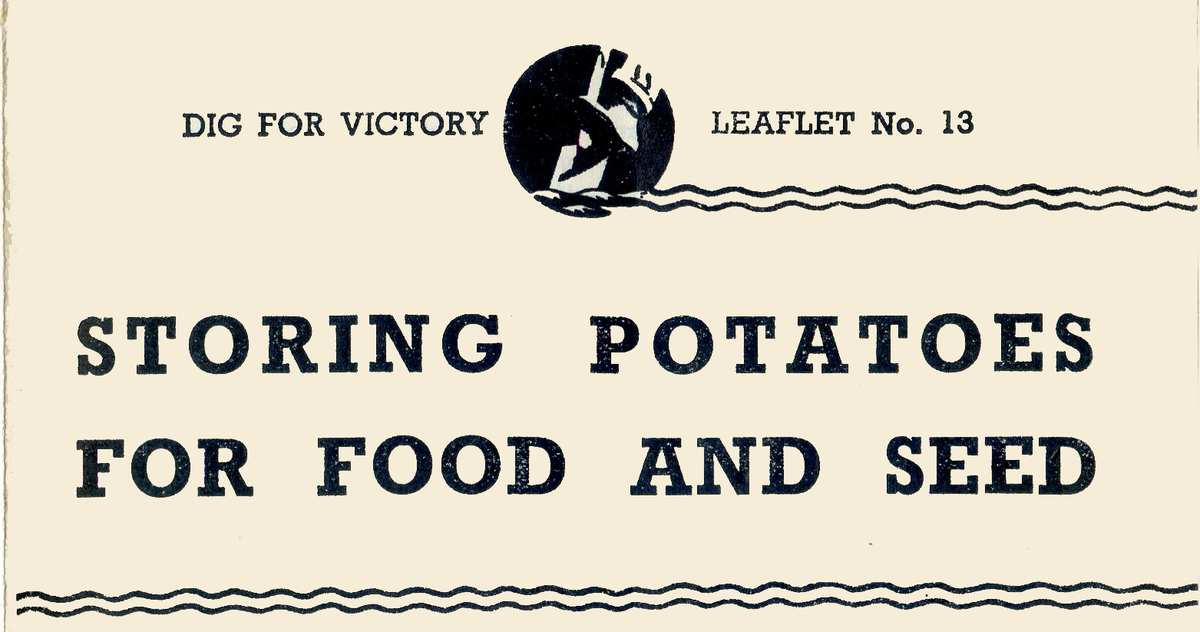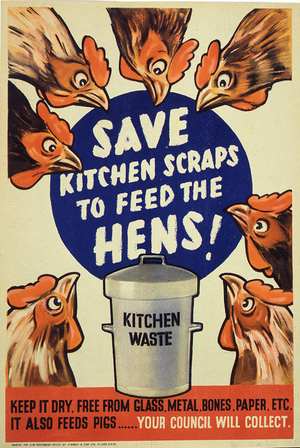 STORING POTATOES FOR FOOD AND SEED
STORING POTATOES FOR FOOD AND SEED
DIG FOR VICTORY LEAFLET No. 13 (Page 3 of 4)
Storage
Where large quantities of potatoes have to be dealt with, a clamp or pie must be made ; but for small quantities a cool, dry, frost-proof shed is the best store. The potatoes are spread in layers on the floor either directly or resting on straw, bracken (fern) or sacking. The depth of the layer of potatoes must not be more than 2 ½ ft. or the tubers may become heated.
Potatoes to be used for food should be covered with straw, bracken or sacking so as to keep out the light and prevent greening. The shed should be ventilated on all suitable occasions. During specially hard weather, every care must be taken to keep out frost.
IN THE LARDER
Where there is no shed suitable for storing, the tubers may be placed in bags or cardboard boxes and kept in a larder. Quicklime or lime and flowers of sulphur lightly sprinkled among the tubers will help to keep down disease. During late autumn, they should, if possible, be looked over fortnightly and diseased tubers removed.
In winter, old sacking thrown over the containers will protect the potatoes from frost, but in very severe weather extra covering should be put on until the end of the frost.
Both quicklime and flowers of sulphur are available nowadays but not for this purpose. In these days of central heating, it’s hard to imagine living in a house where some rooms could drop below freezing in a cold winter
IN CELLARS.
If no more suitable place is available, potatoes may be stored in a cellar ; but careful attention must be paid to ventilation, particularly during the first months of storage. The door should be kept open, and the window also when the weather is suitable.
If the cellar has a dry earth floor, the potatoes may be laid directly on it ; but if the floor is damp, the potatoes should be put in boxes resting on bricks, or placed in a layer 8 or 10 in. deep on straw. The boxes or layer should be covered lightly with material such as straw, dry heather or bracken. The potatoes should be looked over from time to time, and diseased tubers and sprouts removed.
IN A CLAMP OR PIE.
Storing potatoes in a clamp is a subject often raised today. Clamps are a fairly effective method of storing the potatoes but they do suffer from problems that can decimate the crop.
Rot is the biggest problem. As the potatoes release water vapour this can cause rot without sufficient ventilation. If one potato has tuber blight or damage causing it to rot it can quickly spread to the others in the clamp.
Rodents can be another problem if they gain access to the clamp.
Storage in a clamp or pie is in many respects the best method, but it cannot be used if there is danger of loss by pilfering.
Select the driest part of the ground. Mark out a strip 3 ft. 6 in. wide and long enough to take the potatoes to be stored.
Having graded the potatoes, pile them in a heap with sides in the shape of the letter A. Cover the sides and ends of the heap with a 4 in. layer of straw, taking care that the lower ends of the straw are pressed close to the ground, for it is along the edge of the clamp that frost generally gets in. The straw layer should reach almost to the top of the potatoes.
To keep the straw in place, lay earth along the lower edge and a spadeful here and there over the whole of the covering. To keep off rain, a covering of straw is placed over the ridge so thai the ends overlap the straw at the sides. By this means any rain which falls will run down the outside and not into the clamp. The straw should then be covered with a layer of earth 3 in. thick to within 4 in. from the top of the ridge.
At the approach of winter, the clamp must be finished off. This is done by covering it, except along the middle of the ridge, with a thick coat of soil. The soil should be taken from about 1 ft. away from the base of the clamp, so as to leave a shelf on which the covering soil may rest. In this way, a drainage trench a foot or so wide and 6 in. deep is formed.
An outlet is cut in the trench to allow water to drain away. The earth placed on the sides and ends is beaten down firm and smooth with the spade.
A final thickness of 6 in. of earth is quite sufficient to give protection against moderate frosts, but in very severe weather even 12 in. may not be enough. It should be remembered, however, that too much soil encourages the stored potatoes to sprout in the clamp.
Finally, put a thick layer of short litter along the ridge. To keep the ridge clear of soil while covering up the sides, lay a plank on it and move it along as required.
For small lots of one ton or less, the clamp may be made in the shape of a cone, with a round base, built up as high in the centre as the base allows, and well strawed with as straight straw as can be obtained.
Unless the clamp shows signs of caving in, owing to the rotting of the tubers, it may be left undisturbed until February. It should then be opened and the potatoes inspected. If left longer, they are likely to sprout vigorously, thus losing much of their goodness.
It will be necessary to re-make the clamp and to render it frost-proof to guard against spring frosts. In re-making the clamp, care must be taken not to bruise the tubers, as subsequent rotting will then occur.


